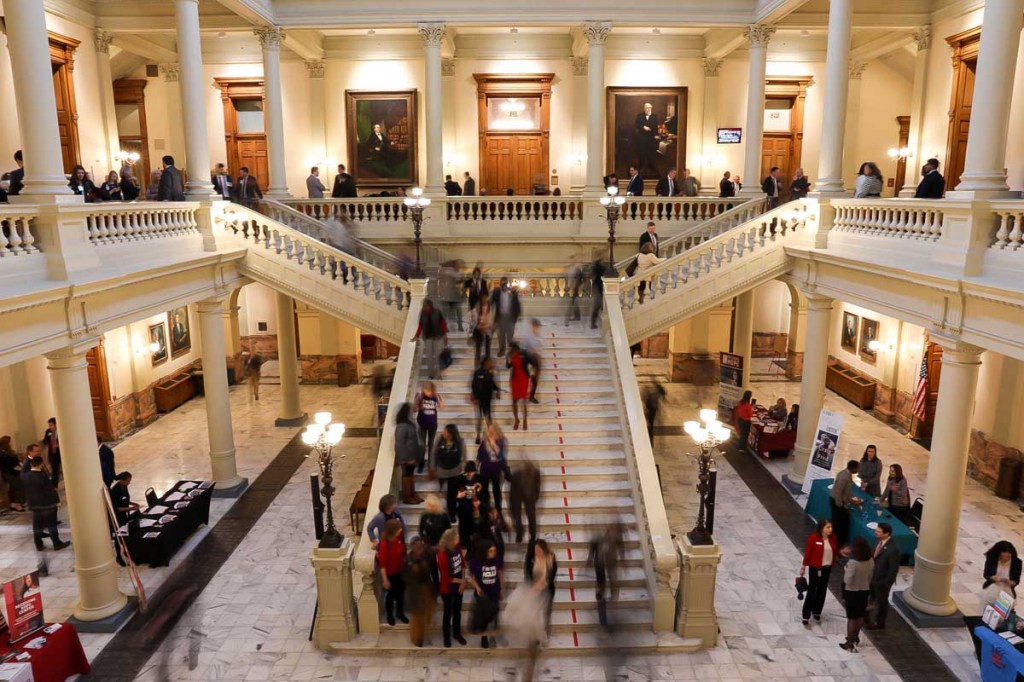Federal relief funds for states limited in use
Published 2:00 pm Tuesday, May 19, 2020

- The Capitol Building bustles with lawmakers and lobbyists on the first day of the 2020 legislative session in Atlanta on Jan. 13.
ATLANTA — Federal funding may brighten the somber outlook of the state budget while easing the anxiety of Georgia lawmakers.
But spending the money will be strapped with stipulations.
In their third joint appropriations meeting Monday, policy experts from the National Conference of State Legislatures gave Georgia legislators a breakdown of the billions of dollars already distributed and on the way to help states recover from the COVID-19 pandemic and economic shutdown.
In total, Georgia is receiving about $8.2 billion in federal aid with almost half coming from the Coronavirus Relief Fund, Molly Ramsdell, director of the Washington, D.C., office for the NCSL, said.
“One of the questions we are asked most often is what flexibility do states have in the use of these funds,” she said. “Unfortunately, I’m going to have to say not much.”
Besides some leeway with some transportation funds and the Governor’s Education Relief Fund, states will need to abide by stipulations for spending, she said.
“As time has gone on, we realized that the flexibility wasn’t actually to the degree that we needed it to be for states to really be able to use money as effectively as possible,” Erlinda Doherty, director of the budgets and revenue committee, said. “Mostly for the revenue shortfalls that most states we knew were going to be experiencing.”
The state announced earlier this month that April tax collections were down more than $1 billion — or 35.9% — which is predicted to be worsen coming months since the state didn’t start shutting down businesses until mid-March. The state’s economist estimated lawmakers will need to use $1 billion to $1.5 billion from the revenue shortfall reserve this fiscal year.
House Appropriations Chairman Terry England, R-Auburn, told CNHI lawmakers don’t have a lot of options and are leaning toward using funds to shore up public health and emergency management expenses.
“It’s certainly going to be very limited because at this point,” he said, “none of the funds can be used to replace lost revenue. So it has to be things above and beyond what you had already budgeted.”
Distribution of Coronavirus Relief Fund dollars to states was based on population, with no state receiving less than $1.25 billion. Of Georgia’s designated $4.1 billion, no more than $1.8 billion was allowed to go to local governments, Doherty said. The national Treasury stipulated that funds were to go directly to coronavirus-incurred expenses and not toward filling the gap of expected revenue shortfalls.
The state is responsible for money distributed to local municipalities, England said, so if they are spent incorrectly, the state is liable. With distribution of funds to local government entities, he said, the state will likely put out rules and regulations that say if it is not spent within the government’s parameters, the local entity is responsible for reimbursing the state.
“We’re ultimately responsible if it’s not spent correctly,” he said.
Policy experts outlined additional funds coming to Georgia for education, food assistance, unemployment and health care.
Austin Reid, director of the education committee, gave lawmakers a picture of the Education Stabilization funds which are already largely available for the state’s use.
Georgia is expecting about $106 million through the Governor’s Education Relief Fund, which can be distributed as grants throughout the education system. Reid estimates another $400 million will be distributed to the state’s higher education institutions through emergency aid based on population of low-income students and the Georgia Department of Education has received $457 million for elementary and secondary school relief — of which $411 million will be distributed based on a federal funding formula.
K-12 schools will be able to use their allotments for increased costs incurred during the pandemic such as costs of meals and distance learning.
Final distribution of $16 billion in food assistance relief funds that will go directly to farmers and ranchers has not been released to states yet, Ben Husch, federal affairs counsel on the natural resources and infrastructure committee, told lawmakers. But a second round of aid is expected.
Agriculture business owners can also apply for emergency loans through the Paycheck Protection Program and Economic Injury Disaster loans.
All states have until Dec. 30 to spend the relief funds which, Ramsdell said, could be extended.





